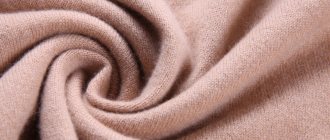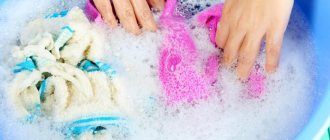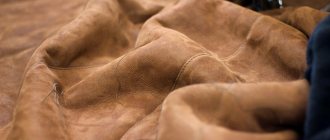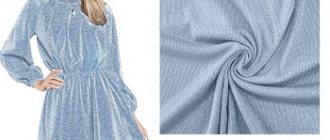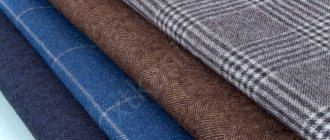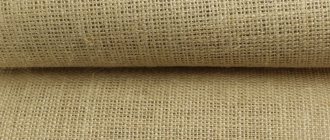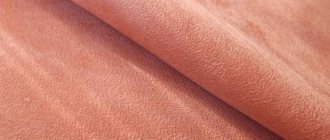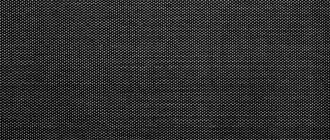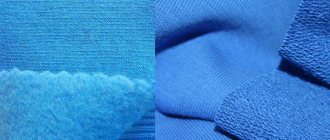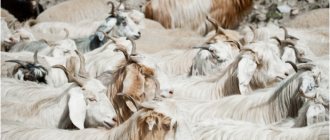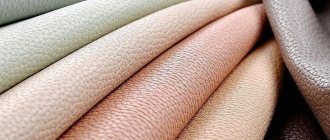History of appearance
Since ancient times, natural suede was obtained by fat tanning the skin of chamois (wild goat). From the French word “chamois”, through the Polish language came “Zamsz”, which is translated into Russian as “suede”.
Roll of material
For your information! Suede leather was produced from the skins of not very large animals, mainly goats. In the 17th century thick material appeared, made from bull skin.
It came to Russia from Poland, so the name is also Polish. Initially they were produced in Nizhny Novgorod, then in the Arkhangelsk province. Industrial production of suede in Russia began only at the end of the 19th century.
Important! Users often ask which is correct: suede or suede. The answer is the second option, since it is a feminine noun.
Colors
Manufacturing stages
What is natural suede made from? Dressing has its own characteristics. The raw material used is the skin of sheep, goats, pigs or deer.
At the first stage, the top layer of dense, hard, slightly elastic tissue is removed from it - the flesh (the so-called fleshing). Next, fatliquoring (suede) is carried out, cod, seal, whale fat (blub) or other fat of plant and animal origin is injected into the skin. During this process, the fat chemically bonds with the fibers of the leather and makes it soft and water-resistant.
Nowadays, formaldehyde treatment and then fatliquoring are mainly used. At the last stage, grinding machines are used to speed up the process. The finished material is brown in color, and can then be further processed with abrasive to create lint on the surface.
You might be interested in: Features of the composition of tapestry fabric: what types of material exist
Wild goat chamois
Where is it used?
Suede leather is used in the textile industry and for clothing. Women's and men's jackets, jackets, coats, blazers, vests, and sheepskin coats are made from suede. In addition to outerwear, suede gloves, hats, berets, and scarves are produced. Things made of warm soft material are worn in autumn and winter.
Fleecy fabric is suitable for sewing both winter boots and summer sandals or demi-season boots, shoes, ugg boots, ankle boots, sneakers, loafers, sneakers.
Suede is used to make and decorate bags, cases, business card holders, and wallets. You can often find suede belts, bracelets, chokers with metal or other decor. Covers for sofas, armchairs, and car seats are made from this material. It is impregnated with special compounds that increase resistance to abrasion and damage.
In addition to sewing, suede is used in technical production for grinding lenses, cleaning optical surfaces, and making fuel filters. In addition, the material is suitable for the manufacture of orthopedic medical equipment.
Basic properties
Suede - what is it? This is leather, so like any material it has positive and negative properties. The advantages of the material include:
- soft, velvety, light;
- elastic, strong, wear-resistant;
- does not allow water to pass through, but allows air to pass through;
- can be washed with soap.
Stain on the shoe
Cons:
- very expensive;
- collects dust and gets dirty quickly;
- requires careful care;
- moisture affects appearance;
- easily greasy and covered with grease stains.
A fabric that stretches (elastic or not)
Natural suede stretches only within the limits that the skin allows. This is a lot, but such a material cannot be called elastic. To obtain such properties, a certain kind of artificial substitute is used.
The problem is solved like this:
- If viscose or polyester knitted fiber is used as a base for spraying, the stretchability of the material increases noticeably.
- You can increase elasticity by adding lycra and stretch to the non-woven base. 2% spandex is enough to provide the material with high elasticity.
- The woven material can be made elastic if microfiber is pre-made with a minimum diameter.
It is impossible to make natural leather more elastic than it already is.
Kinds
Many people are interested in what suede is, what it is made of, and what kind of leather it is made of. Deer, sheep and goat skins produce the finest, softest skins, while pork skins produce rough but thin skins. Suede made from the skin of large animals is thick. Previously, it was used to make military uniforms, clothing for hunters and travelers. Now used in the production of footwear and orthopedics.
Split leather example
There is another type - split leather. It is obtained by cutting horizontal layers of several layers of cattle hide. The output is rough, thin, strong non-woven suede.
Note! In addition to natural suede, there is also artificial suede, which is much cheaper.
Rules of care
Suede is a natural material that requires careful care. Shoes, clothes, gloves are made from it, and each type of product has its own care rules. How suede looks depends on proper care.
Suede gloves
Shoes
Suede - what kind of shoe material is it? For shoes, three types of rough suede are usually used - thin, medium and thick. The top (for example, the boot) is sewn from thin and medium, and the bottom from thick.
Shoe upper
Shoes are susceptible to contamination (open pores actively absorb dirt). Moisture causes “gluing” of the villi. For this reason, it should not be worn in the rain, through mud or washed. If it gets wet, you just need to dry it, clean it and comb the pile with special brushes.
You might be interested in what fabric is used for bathroom curtains
Important! Shoes should be dried flat (stuffed with paper), cleaned only when dry.
Dust and dirt (dried) are removed with special brushes. To remove grease stains, you can use special products or pure gasoline without impurities, for example, for lighters.
Note! You cannot use creams or wax to care for your shoes, as this can completely ruin the material.
Outerwear
Caring for outerwear is no different from shoes. Suede quickly becomes dirty, greasy and prone to oil stains; it is not suitable for traveling on public transport. Must be protected from moisture. Under the influence of water, the skin can become deformed and lose its velvety quality.
Note! The material actively absorbs moisture thanks to its pores, swells and does not allow water to pass through. When dry it becomes hard.
For cleaning you need to use branded products. Cleaning greasy areas is possible with the application of gasoline. Then this place needs to be carefully wiped with a sponge. Rules of care:
- vacuum constantly;
- brush regularly;
- try not to soak in water;
- wash, hanging on hangers, with special brushes and dry only in a straightened form;
- do not soak;
- Do not dry in front of heating appliances.
Suede jacket
How to care for gloves
The gloves are made from the thinnest and softest suede; they must be worn carefully, do not soak them, and when drying, fill them with paper. In addition, you should comb with a brush to maintain the pile, otherwise “bald” areas may appear. You can get rid of greasy stains with pure gasoline; it is more convenient to put a glove on your hand. You can also clean it with synthetic products.
How to choose
Several criteria will help you choose high-quality leather shoes:
- the product is comfortable, fits in size, follows the shape of the leg;
- the sole bends easily, the upper of the shoe is plastic, no kinks are formed;
- the seams are even and neat;
- high price;
- The label contains all the information about the manufacturer and the product.
In the modern shoe industry, it uses new technologies that help create products from artificial material that visually resemble a natural product. You can determine naturalness using simple steps:
- drop water - natural leather will absorb it, artificial leather will repel it;
- touch – the quality material is pleasant, slightly rough;
- evaluate the processing of the seams - when using natural material, the seams are soldered and a bead is formed.
When choosing shoes or boots, it is very difficult to distinguish natural leather from artificial leather. Consumers should be aware of the following information:
- natural material retains heat - if you put your finger on the surface, you can feel how it heats up;
- the front side of the leather is characterized by a unique relief; artificial versions have a clear symmetrical pattern;
- high-quality shoes are heavy and have a specific pleasant smell;
- You can check the material for naturalness from the reverse side, on the cuts.
Unscrupulous manufacturers often combine material using high-quality inserts in the cut areas.
Differences between natural and artificial materials
Suede is a good material that has a number of remarkable properties. Looks beautiful, soft, pleasant to the touch. Disadvantage: expensive. Manufacturers have come up with a number of artificial materials that are cheaper, do not allow water to pass through, and do not quickly deteriorate in appearance. These include velor, faux suede, leather, eco-leather.
You might be interested in this All about ribana, description of fabric with lycra and comparison with cashhorse
Artificial material
Velor is a type of fabric with pile. It is not leather; rather, it is a type of textile used for upholstery of car interiors and furniture.
There is eco-leather, or leatherette in other words. Eco-materials are not so soft. Leatherette is a material based on fabric: a polymer film is applied to it. The products are elastic, do not change color, do not get wet and do not allow water to pass through. Leatherette is sensitive to high temperatures.
Faux suede is a fabric base coated with polyester, which creates a pile. It looks like suede, but the color is uniform and can have many colors. It is afraid of solvents and bleaches, washes well and does not lose its properties.
Advantages of suede shoes
Almost every self-respecting shoe manufacturer necessarily has a line of suede models in its arsenal. The reason is simple - there are many undeniable advantages, including:
- elegant and attractive appearance;
- significant potential for compatibility with clothing; rich color palette;
- softness and elasticity, providing maximum comfort during use;
- breathability, allowing feet to “breathe” in shoes;
- thermal insulation properties that maintain a constant temperature inside the product;
- antistatic and hypoallergenic;
- durability, subject to proper care.
Differences from other materials
I wonder what suede is, what is the difference between it and other materials. Suede is very different from other natural materials. For example, nubuck. This is a material made from the skins of large horned animals using the chrome tanning method. Like suede, it is polished with abrasive. Outwardly, it is very similar to suede, but much cheaper, less elastic, the fibers are shorter, and it gets dirty faster. Nubuck is always thicker, only the front side is processed (the back side is not), it is denser, and has lower wear resistance.
Cleaning cloth
Suede is still a popular material and is widely used. It is used to make clothes, shoes, gloves, and is used to wipe lenses, as a filter in industry. However, over the years, one thing has remained constant - care, which must be strictly according to the rules, otherwise there is a chance that the material will quickly become unusable.
Shoe leather
Genuine leather is one of the most ancient materials for making shoes and haberdashery: bags, wallets, business card holders, belts and other useful items. It is elastic and durable, breathable and protects from moisture, wind and cold. To obtain shoe and haberdashery leather, the skins of large and small cattle are used. Depending on the purpose, method of processing, dressing and tanning, and the type of raw materials, genuine leather is divided into many types.
Shoe leather
Shoe leather includes the material for the top and bottom of shoes, as well as the lining.
Leather for shoe uppers is a soft leather product used to make parts of different types of shoe uppers. Leather for shoe uppers during use, as well as in the manufacture of shoe parts, is subjected to repeated stretching and compression, bending, and exposure to dust, dirt, and chemicals. The leather must have sufficient air and vapor permeability and water resistance.
Leathers for shoe uppers are divided into:
- by type of raw material,
- configurations,
- tanning methods,
- color, character and finishing methods, by area and thickness, as well as by grade (four grades).
Leathers for shoe uppers are divided according to fastening methods:
Leathers for shoe uppers using screw-pin fastening methods include:
— shoe leather — a leather product used for making parts of the uppers of heavy shoes;
- sandal yuft - for the top of sandals.
Sandal yuft, compared to yuft for heavy shoes, should be more elastic, but not hard, less fatty, with a well-polished face and color, resistant to dry and wet friction.
The main task in the production of yufti is to obtain leather that is soft, has a certain ductility and plasticity, is highly resistant to repeated bending and stretching, and is highly waterproof. This is ensured mainly by a strong separation of the microstructure (long-term liming) and the introduction of a large amount of fatliquoring substances. In addition, yuft must be resistant to sweat, since the tops of heavy shoes are hemmed without lining, as well as vapor permeable to remove sweat.
According to the types of tanning agents used, they are distinguished:
- vegetable yuft;
— chrome tanning;
- chrome vegetable tanning.
By the nature of the finish: with a smooth face and threaded. By finishing method:
- with a natural face;
- artificial face;
- with a polished face;
— with bakhtarma finishing;
- impregnated (pork skin).
By color: black, colored and natural.
Leather for shoe uppers using thread-glue fastening methods. These include chrome leather for shoe uppers, suede, patent leather, and split leather.
Chrome leather for shoe uppers is a soft leather product made from animal skins and tanned with chromium compounds. Depending on the type of raw material from which they are made, these leathers are called:
— chrome rim;
- chrome outgrowth;
— chrome semi-leather;
— chrome cowhide;
— pigskin chrome chevro (leather made from goat skins with a skin area of up to 60 dm2);
- goat chrome (with a skin area greater than 60 dm2);
- chevret (leather made from sheep skins).
Chrome leathers for shoe uppers are divided according to configuration into whole leathers, half-leathers, and half-leathers. According to the nature of the finish, they are divided into smooth and threaded; by finishing method - on leather with a natural face, leather with an artificial face, nubuck leather (with a sanded face), velor leather (with a sanded lining).
Based on the size of the skin area, they are divided into seven groups with extreme values from 20 to 200 dm2. Based on the thickness of the skin, they are divided into thin, medium, thick and extra thick; Each type of leather has a specific thickness.
Chrome leathers for shoe uppers should be soft to the touch, normally tanned and burnished, evenly colored, without searing, without face screeding, without stains, well cut, well dressed, without folds and stripes from polishing or fluffing, with a smooth fringe, with the same thick over the entire area, with an even color.
There are leather for the bottom of shoes, attached by screw and thread-glue methods (welt, stitching and adhesive fastening). Such leather is a material that is rigid in bending and compression, produced from the skins of cattle, camel, pork, sea animals and horses using various tanning substances.
Leather for the bottom of shoes is divided by type of tanning, nature of finishing, thickness at a standard point (into 5-6 categories - from 1.75 to 7 mm), grade (4 grades) and configuration (whole leather, half-leather, etc.) .
Usually, when tanning leather for the bottom of shoes, combined tanning is used with chromium compounds, tannins, syntans, and sometimes with zirconium and aluminum compounds. Chrome-tanned leather, despite its high wear resistance, has not found widespread use due to a number of disadvantages - high wetness, loss of shape, low coefficient of friction when wet, difficulty in finishing.
Leather for the bottom of shoes is used to make soles, insoles and other shoe parts. Plantar leathers must be able to withstand abrasion, compression and bending deformation well, and also maintain linear dimensions when moistened and subsequently dried. The necessary properties of plantar leathers are ensured by the selection of leather raw materials.
Shoe lining leather is intended for shoe lining parts. It is obtained from a tanned semi-finished product rejected during the production process, which is not suitable for shoe uppers. Lining leathers are classified according to type of tanning, color (natural or colored) and finishing (faced or bakhtarma).
Shoe leather by finishing method
Smooth skin
Smooth leather is a general designation for various types of leather with a dense and smooth grain surface. For example, aniline - leather dyed with organic dyes with minimal technological processing, and Nappa - especially thin semi-aniline leather with increased elasticity, produced from cattle hides.
Smooth leather or cowhide is produced from the skins of young, dairy calves, half-skinned, outgrown, cow, steer, bull, from the skins of goats, sheep, and in some cases - from pig skins or from the skins of foals.
To produce smooth leather, the best raw materials are used, which are processed using the most modern technologies, preserving the natural pattern as much as possible. The smoothness of the leather is achieved by special treatment of the top layer of the entire hide - by spraying paint and sometimes wax or resin onto the leather surface. This treatment best preserves the natural surface of the upper side of the leather, which is sometimes enhanced with dust-like embossing.
Smooth leather is considered the most valuable in shoe production; it is durable and elastic, with a beautiful grain. Smooth leathers are widely used for a wide variety of women's and men's shoes.
patent leather
Patent or patent leather is a type of chrome-tanned leather with a shiny, mirror-like surface. The leather is treated with a varnish coating based on quick-drying linseed oil, or with a synthetic varnish based on polyurethane resin, or duplicated with a varnish film. The quality of patent leather directly depends on the quality of the raw materials used and the lacquer component. Covered with a primer layer based on natural cellulose, tanned leather is coated with varnish based on polyurethane resins. The primer layer protects the skin from loss of softness and flexibility.
Varnishes differ from each other - they can be glossy and matte, colored and transparent, preserving the natural color of the skin. The color range of varnishes is unlimited - from bright to natural options. Flakes of silicon, mica and other materials can be specially added to the varnish to create decorative effects.
The surface of patent leather can be smooth and perfectly flat or with original embossing on the leather to create the effect of lizard and crocodile skin. Natural reptile skin is often coated with varnish to give a smooth and mirror-like surface. Patent leathers are represented by “Naplak” articles.
In addition to its visual appeal, patent leather is also known for its durable nature. The coating process responsible for the premium shine creates a waterproof barrier that keeps the leather in good condition while allowing it to remain flexible.
Patent leather varies greatly in quality. Good Italian-made patent leather will never be scratched by a fingernail, even if the leather itself is soft, it can withstand repeated bending, stretches like natural leather, leaving the varnish coating unharmed, and is not afraid of frost and heat. Patent leather produced in China or South Africa is easily scratched by a fingernail, and the varnish layer bursts with slight stretching and bending. In Russia, it is almost impossible to find Italian-made patent leather due to its high cost.
Patent leather is used to make shoes and haberdashery products. Most often, patent leather is used in the production of dress shoes intended for formal events. For example, women's shoes and men's boots. Patent leather is also used in the manufacture of bags, wallets and other fashion accessories, as its glossy shine remains beloved and desired.
History of patent leather
The original patent leather was first created by Seth Boyden in 1818. He crafted the leather using linseed oil varnish to seal the leather's surface and create a unique shine. These days, patent leather is most often created by applying a plastic coating. Although it looks like faux leather, patent leather is made from genuine leather and sells for a higher price.
In the history of fashion of the 20th century, patent leather was on the rise several times. In the 1960s, she helped young women of the post-war generation find their image, and in the early 1980s, she became one of the mouthpieces of the sexual revolution. Today it is becoming an attribute of chic and power. One has only to take a closer look at it and the whole play of its brilliance fills you with that special charm that does not need any decoration.
Shoe leather by type of tanning
Saffiano is vegetable-tanned goatskin leather, lightly tanned and brightly colored.
Shagreen is a soft vegetable tanned leather made from the skins of sheep or goats, which has a beautiful fine relief pattern.
Laika - leather made from the skins of sheep, goats, and dogs; tanning with aluminum alum using salt, flour and yolk; the leather is soft, thin, and is used to make gloves.
Suede
Suede is a type of leather obtained from the highest quality skins of elk and reindeer. Suede is obtained by fat tanning. During tanning, the skins pass through a special cutting machine, which uses sharp and long knives to separate the layers of leather into the inner and outer parts. The front side is a melon layer processed by polishing. Thus, the leather is processed on both sides - the result is suede.
When tanning suede, 70% of expensive tanning fats from the weight of the leather are used, and the tanning process itself is very labor-intensive and takes from 3 to 7 days. Therefore, the production of suede for ordinary consumption is currently almost not used. People mistakenly assigned the name and all the properties of suede to velor.
Suede has ductility and porosity, which makes it highly breathable. Suede has a velvety surface without shine, thick low pile, it is thin and soft, and perfectly breathable. Suede is used for sewing shoes, gloves, haberdashery, and clothing. The cost of products made from natural suede is very high, but they are durable.
Suede is used in technology as a filter material for separating water from gasoline and as a polishing material for optical glasses. Suede can be washed in soapy water without compromising its quality, which is why it is called “washable leather”. It is characteristic that after washing and drying the suede remains soft and at the same time dense and not rag-like.
Velours
Velor from French velours – velvet, from lat. villosus - hairy, shaggy. Velor is a natural material obtained from fluff, outgrowth, half-leather, goat and pork skins. Velor has a low, thick, uniform pile and low strength.
Velor is produced by sanding the back of the mesh surface of various types of leather that have raw material defects on the front side, to even out the thickness and improve hairiness. To obtain velor, conventional chrome tanning is used for up to 12 hours.
To obtain velor with soft, full and delicate leather to the touch, with a velvety, finely fleecy surface and deep coloring, special finishing methods are used. Careful sanding and painting of velor is essential: it is more difficult to paint velor deeply and evenly than grain leather. In terms of chemical composition and physical and mechanical properties, velor differs little from the corresponding types of full-face chrome leather.
Velor is often mistakenly confused with suede, but natural suede is very rare. If velor is washed and dried, it will lose all its properties: it will become inflexible and rough to the touch, the pile will stick together and fade. During wear, the uppers of velor shoes quickly get wet, dirty and lose their shape, so they undergo special treatment. Velor is used to produce the uppers of sports, indoor and dress shoes.
Split velor
Split velor is a layer of natural leather obtained in the tanning process as a result of layering or sanding, after removing the front layer. When sanding, the skin is divided into 3 to 6 layers, depending on the thickness of the skin.
A distinction is made between the front, middle and inner or melon layers. Various high-quality leathers are produced from the facial layer, which has natural grain. The layers of the split leather part, after applying an adhesive coating, are called artificial measure; they also produce leather of lower quality.
Split velor is obtained from split leather, which does not have a front side at all. Hide and split ends are used to prepare technical gelatin, glue and other collagen dissolution products. Split velor is used for the production of shoes, mittens, and workwear. The distinctive qualities of velor are a fleecy top layer, uniform and thick pile, density, softness, ductility and high thermal conductivity.
Nubuck
Nubuck is a chrome-tanned leather that is obtained by sanding the grain of the leather with fine abrasives to give it a refined appearance. The process of this treatment turns the smooth surface of the skin into soft and velvety.
One of the subtypes of nubuck is oiled nubuck. This is leather that, after sanding, is impregnated with a special oil-based substance. Oiled nubuck has a slightly oily surface, an “antique” look, and is not afraid of water.
Nubuck has porous soft leather, has a soft, almost imperceptible pile, it is very wear-resistant, has excellent breathability - the skin “breathes” in shoes and clothes made of nubuck. Nubuck cannot be replaced for the manufacture of men's and women's shoes. Colored nubuck inserts are used in the production of children's shoes.
Shoe leather by type of leather raw material
Cattle or cattle hides are the most sought after and valuable for leather production. Cattle leather is valued for its noble texture, elasticity, strength and large surface area of the resulting hides. This skin is quite thick - up to 2-3 mm. Produced using chrome and vegetable tanning methods. They are divided into several types, depending on the age of the animal, and have specific names: opoek, outgrowth, cow, bull.
Using new methods of processing, painting and embossing the skins, many textures and colors are obtained that imitate the skin of fish, monitor lizard, crocodile, ostrich or monitor lizard. Cattle leather is most often used to make clothes and shoes, bags and belts.
Sklizok is the skin of unborn calves, 1.0 - 1.4 mm thick, used to make shoe uppers.
Opoek - skins of dairy calves, thickness from 0.5 to 1.4 mm. The skins of such animals are very delicate and soft, elastic and strong. The skins of cows fed on milk and water are somewhat rougher. Feather leather is produced using the chrome tanning method. It is smooth, soft and elastic, and has a very beautiful measure. Using another tanning method, you can get velor or nappa from the felt.
When finished, the moldings acquire a very beautiful appearance. Opoek is a common material for light clothing and shoes. The collar stretches well, has a pronounced measure, is resistant to deformation, and therefore is excellent for making shoes.
Outgrowth is the skin of calves that eat plant foods, the skin thickness is 0.7 - 1.6 mm. Skins with a thickness of 2.5 mm are sawed on splitting machines, also producing splits. The skin of the outgrowth is much rougher than that of the sapling. Produced by chrome tanning for leather goods and shoe uppers.
Half-leather or half-leather - the skin of calves over 1 year old, 1 - 3 mm thick, tougher and denser than the outgrowth. Leather is produced by vegetable, combined (yuft) or chrome tanning. Chrome-tanned leather is used for shoe uppers, vegetable tanned leather, thanks to its fine grain and beautiful beige color, is used for souvenirs. Thicker skins are used to make industrial leather.
Bull - produced from the skins of young animals up to 4 mm thick, vegetable or chrome tanned, producing yuft, for the production of insole leather and split leather.
Yalovka - cow skins, thickness 1.2 - 4.0 mm. Thin leathers are produced by chrome tanning, resulting in elastic leather with a smooth, beautiful outer layer of leather, which is used in the production of shoes. Leather with a thickness of more than 2.5 mm is also used to make shoe splits; medium-thick skins are used to make rawhide and saddle leather; thicker ones are used for yuft, sole and technical leathers.
Bychina is the skin of a young bull, up to 5 mm thick, produced and used in the same way as cowhide.
Bugai and buffalo - bull skins, the thickest and heaviest among cattle skins, have a rough and loose structure, therefore they are used for insole, sole, industrial and rawhide leathers.
Goat and sheep skins are used to make very durable, thin and soft leather with a fine wavy pattern, which is used in the production of clothing, shoes, various leather goods and furniture upholstery. Goat skins compare favorably with sheep skins in their density, waterproofness and elasticity. Sheep skins are most often used for fur raw materials, but they are also used to make leather.
Chevret is chrome-tanned leather, 0.6 - 1.2 mm thick, from young sheepskin obtained from semi-fine-fleece, fine-fleece and coarse-wool sheep of steppe and Russian breeds.
The structure of chevret is loose and viscous, so mechanical strength has to be increased by treating the front surface with polymers and other chemicals. Compared to chevro, chevrette is less elastic.
Chevrete is most suitable for the shoe industry; a large number of women's shoes are made from this leather. Chevret is often used to make haberdashery and is also popular in the outerwear industry.
Shagreen is a soft, rough goat or sheep skin. The skins of merino sheep are used to produce leather called “chevrette,” which has low density and strength, but has good ductility. Coarse-wooled breeds of sheep are used to produce leather for making sheepskin coats - due to the denser flesh, it can withstand tight stitching better.
Sheepskin is a rather expensive leather, very delicate and soft to the touch, sheep skins are usually small in area. The skins of different breeds of sheep have different uses. Sheepskin is especially valued in the production of outerwear - jackets, jackets and accessories - bags, gloves.
Saffiano is a soft, thin vegetable tanned leather, usually dyed in bright colors, sometimes made from the skins of calves, foals and sheep.
Chevreau - from French. chevreau means kid - produced from the skins of young goats up to 6 months old of dairy and meat and dairy breeds, up to 1 mm thick. For the production of chevro, raw materials from India are used.
Chevro is one of the most expensive chrome-tanned leathers. Chevreau has a beautiful measure with a clearly defined grain and has a significant tensile strength, up to 50 MN/m2.
Chevre differs favorably from sheep leather in its density and elasticity, breathability and waterproofness. The mechanical properties of chevro are lower than those of cattle leather; it has a beautiful, pronounced waviness on the floor and collar.
The dermis of goat skin consists of fairly thick and strong bundles of fibers, closely intertwined in a direction mainly parallel to the facial layer, which gives the tanned leather softness. The face of leather made from goatskin is tougher and stronger than leather made from sheepskin.
Thanks to its beautiful appearance, high strength with low thickness, softness and lightness, elasticity and beautiful appearance, chevro is the most high-quality material for the manufacture of shoe uppers. They produce women's and men's dress shoes.
Goat - produced by chrome tanning from the skins of adult animals. The hallmark of goatskin is a small wavy pattern. High-strength chevro and saffiano leathers are obtained from goat skins, which are soft, dense and durable. Goatskin is thin and uniform in thickness, waterproof. Goatskin is used to make shoes, clothing, upholstery and haberdashery.
Leather obtained from pig skin is different from cattle. Pork skin - has thick subcutaneous tissue, which makes up about 50% of the total mass of the skin. Pigskin has an unpresentable perforated texture and lacks strength, which is why it is the cheapest of natural leathers.
Pigskin is extremely rarely used as the main material for making clothing; saddlery, haberdashery, and shoe lining are made from it.
Horse leather
Foal - the skins of dairy foals, is considered a valuable fur raw material, but if due to a defect it is not suitable for fur production, it is used in tanning.
Foal foal - the skin of foals that have tasted plant food.
Valuable types of leather from elk, deer and young stallions are quite rare. The most elite types of leather from the skins of reptiles and fish: crocodile, python, monitor lizard, stingray, eel, pike, carp. Ostrich is considered an exotic type of leather, and crocodile is considered the most expensive. The price of the skin of one specimen reaches several thousand dollars.

